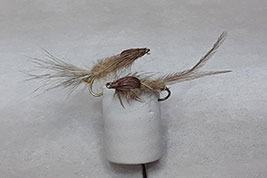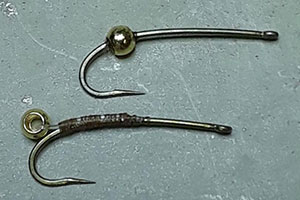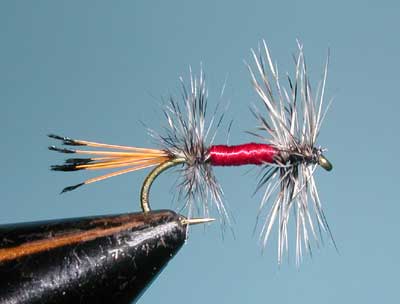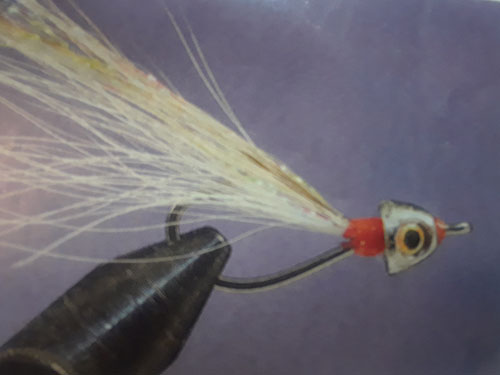Sparkle Wing RS-2
Charlie Craven
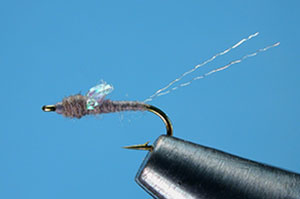
Translated by Carl Wuebben
The ubiquitous RS-2 has gained a bit of flash and sometimes this can make all the difference. Fish this fly as you would a regular RS-2. The sparkle wing RS-2 has become a standard pattern and I think you’ll find this to be a valuable variation to carry in your fly box.
PATTERN
HOOK – TMC 101 # 16-24
THREAD – Gray 8/0 (70 Denier) UNI
TAIL – White Fluoro Fiber
ABDOMEN – Adam’s Gray Superfine Dubbing
WING – Mini Flat Braid, Pearl
THORAX – Adam’s Gray Superfine Dubbing
HOW TO TIE
- Debarb hook, mount in vise, start your thread at about two eyelets from the eye then clip off the tag end of the thread.
- Tie in a single 4 inch strand of white Fluoro fiber right where your thread is now. Tie it in with only a turn or two of thread and at the center of the Fluoro fiber (one half forward the other rearward.) Don’t move rearward, you just want to capture the material only at the tie-in point. Pull both ends of the Fluoro fiber back along the top of the hook and wrap just slightly back over the bases of the Fluoro fiber to get them laying on top of the hook and pinned back.
- Leave the thread hanging just behind where you started your thread then dub the thread (twisting the dubbing between your fingers) with the slimmest amount of gray dubbing you can. We want to keep the body of this fly very slim. Be sure to leave a small portion (an inch or so) of the thread bare between the top edge of the dubbing and the hook shank. We will use this bare thread to work back over the tails to the bend of the hook, tying the tail down, forming a thread base and positioning the start of the dubbing all in one fell swoop!
- Hold the tail fibers up and slightly toward you as you wrap the bare section of the thread back to the bend over the top of the tails, keeping the tails centered on top of the shank as you go. The dubbing should not come into play as you wrap back (just the bare thread.) You should be right up to the start of the dubbing when you reach the bend of the hook.
- Make the first very thin wrap of dubbing under and behind the tail fibers. This will help lift the tails a bit from the bend of the hook. Pull the dubbed thread forward tightly to butt the dubbed thread up against the back of the tails. Make the next turn of dubbing immediately in front of the base of the tail and then continue wrapping the dubbing forward, up to where you started your thread, in a smooth even layer.
- Wrap the dubbing back to the midpoint of the abdomen, building a taper on the front half of the body. The dubbing must be very thin for this to work (just barely cover the thread.) Then make a couple more turns of dubbing over the front third of the abdomen to finish off the taper. You want a nice sharp shoulder at the front of the dubbed abdomen. Wrap the bare thread forward from the front edge of the abdomen to the hook eye and back again, making a thread base for the wing that comes next (taper is small in front and large in rear.)
- Cut a 1 inch length of mini flat braid and fold it into a loop. Fold the loop down flat and pinch it against the hook at the front edge of the abdomen. It should be one third the length of the abdomen. Press the thumb of your material hand down on top of the loop to hold it in place while you make a couple firm wraps of thread over the base of the flash loop at the front edge of the abdomen. Clip the wing butts as close as you can behind the hook eye.
- Dub the thread with another very thin layer of dubbing and begin wrapping it, with the first turn immediately behind the hook eye. Then dub the thorax from the hook eye to the base of the wing and back again, tapered thin to front and fatter toward the abdomen. Dub another thin dubbing noodle and wrap back to the base of the wing again. You should see a nice taper by now. Bring the noodle forward again to the hook eye, finishing off the thorax shape and ending with bare thread at the very back edge of the hook eye.
- Whip finish right behind the eye and clip the thread tag end. Pull the tails forward over the top of the fly and trim them so they are about one and a half shanks long. You can also tie this with a black or olive body. Just change the dubbing color.
TIE UP A DOZEN OR TWO – AND GO FISHING*** But remember to practice C.P.R. (CATCH – PICTURE – RELEASE)


